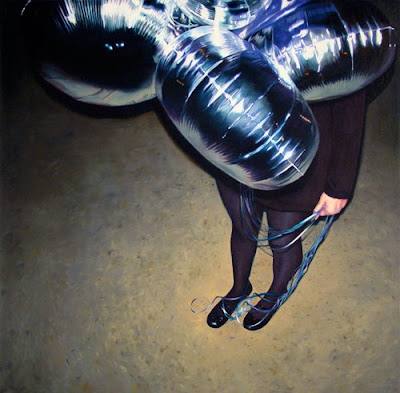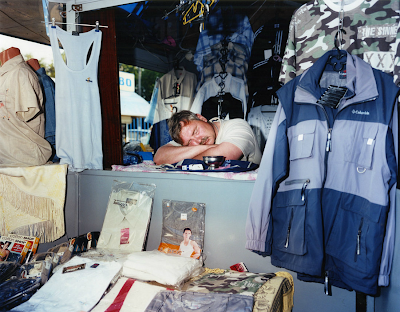Yet another Top 10 coming your way, hope you'll enjoy it.
Also slapping in a working late mixtape this week, to all of you graveyard shifters:
Working Late Mixtape
Take care.
Mr. J
Monday, September 19, 2011
1. Elizaveta Porodina
In her photography, she shows us Glam Rock and fairy worlds, interprets fashion with an often sexual aesthetic which is shaped by her psychological knowledge and full of hidden emotion.
She prefers to work with natural light-a preference which has emerged from the initial lack of equipment and the will to capture the "right moment". Her photography is never just fashion, it also shows a "below" which attracts us as the visible piece of skin of the perfect, mask-like make-up of a geisha.
See more work by Elizaveta Porodina HERE
2. NEW WORK by Minni Havas
Sunday, September 18, 2011
3. Gotye - Somebody That I Used To Know (feat. Kimbra)
Directed, produced and edited by Natasha Pincus
Body art by Emma Hack
Cinematographer and colourist: Warwick Field
Scenic artist: Howard Clark
Key grip: Rob Hansford
Assistants: Rose Cidoni, Claire Leighton, Rob Murray
Original artwork by Frank De Backer
4. Santtu Mustonen - Non Animation Work
See more work by Santtu at Agent Pekka HERE
7. Jeff Ramirez
Arrested Motion sat down with Ramirez to learn more about him and his creative process. Here was one of the Q and A's I enjoyed the most.
AM: It seems that many of your paintings feature people who are somehow concealing their face in some way or another. Is there some sort of conscious effort to paint this way and if so, what does it mean?
JR: Getting back to my adolescence, I always felt like I was a different person depending on whom I was around, whether it be friends or family or whomever. It often felt unnatural, like a performance. Gradually, I realized that I had grown really skeptical of images and their supposed content, even images of myself. I just didn’t relate to them on the same level as I think a lot of people might. I was more interested in them for context or absurd moments than as mementos or reminders.And now, with the rise of digital photography, social networking and this blurring of reality, there is a real lack of emotional truth in many of these supposedly candid shots. I’m interested in using that look to create new images that do have emotional truth for me and so it is often necessary to obscure elements in order to make for a different experience from these rather ubiquitous images. ( www.mymodernmet.com )
8. Studio Muti
They are based in the beautiful city of Cape Town, South Africa.
After spending over 4 years with local illustration pioneers Am I Collective, Miné and Clinton decided to team up and form Studio Muti. Together they combine their creative talents to provide illustration, typography and design both locally and abroad.
See more work by Studio Muti HERE
9. Anna Skladmann
Born in 1986 in Bremen, Germany. Anna is a freelance photographer that lives and works between New York and Moscow. She graduated with a B.F.A in Photography from Parsons School of Design in 2008 where she studies partly in Paris and New York.
See more work by Anna Skladmann HERE
10. Dana Bell
Dana Bell: A Delicate Balance
An agitation of hands. Cries and whispers. An inner monologue manically externalized. Fending, grasping, beckoning for something—anything—a solution… or an escape route…
This is the embodied language of ‘the hysterical woman;’ the dangerously reductive diagnosis not so long ago given to women who exhibited signs of significant psychological distress. Historically, the fluctuation of women’s emotion and temperament has been highly pathologized. Like the Cassandra of myth, women’s troubles and anxieties were dismissed as rumblings of a weak or defective mind. Biology was destiny, it was only a matter of time before a fragile psyche was interrupted by the real world, and a woman descended into full-on psychosis. The hysterical diagnosis, rooted in antiquity, transformed into a pervasive archetype, with far-reaching consequences. The narrative of ‘the hysterical woman’ reached it peak in the the Victorian Age, when the prevalence of the “disorder” and its corresponding “treatment”—from incitement of “hysterical paroxysm” (i.e. placating pelvic massage) to institutionalization and ultimately to such extremes as lobotomy—was used as a means of socio-cultural domination and control.
Though this diagnosis has declined sharply in the last century, and its assumptions have been demystified, the archetype still lingers in the public consciousness…and in the corresponding cultural production. The archetype, long referenced in the history of Western Art, has frequently been the subject of film. American Cinema is rife with depictions of women on the verge of some sort of nervous breakdown. In A Delicate Balance, Dana Bell’s inaugural show at Louis V E.S.P., she examines some of these depictions in classic Hollywood films.
Bell critically interprets a broad section of hysterical collapse, as dramatized by a who’s who of great actresses. There’s descent into madness, and subsequent forced clinical institutionalization: Jessica Lange, as tragically wronged actress Frances Farmer, in Frances (1982); Gena Rowlands in husband John Cassavetes’s A Woman Under The Influence (1974); Joan Crawford in The Caretakers, (1963); Olivia de Havilland in The Snake Pit (1948). There are accounts of unaddressed psychological trauma wreaking dissociative havoc internally, via multiple personality disorder: Joanne Woodward in The Three Faces of Eve (1967) and Sally Field in Sybil (1976). And trauma leading towards an external acting out, (cruel abuse of others: Faye Dunway, as Joan Crawford, in Mommie Dearest (1981). And of course there’s the requisite general mania due to family dysfunction, drugs, and overwhelming pain: Katharine Hepburn in Sidney Lumet’s version of Eugene O’Neill’s Long Days Journey Into Night (1962), and Vivien Leigh in A Streetcar Named Desire (1951).
Dana Bell paints films stills as a means of distilling (psychological) motivation, placing sharp focus on the physical realization of intent, and how gesture transforms from dramatic idiosyncrasy to a vernacular body language, or a clichéd response. In (A) Delicate Balance, she has created a reductionist study of women who, through a perceived loss of sanity, have lost recognition as an individuated self. The “hysterical woman” is essentialized. Bell portrays the women as they are perceived– faceless, reduced to gesture erased of nuance, of subjectivity…
See more work by Dana HERE
Subscribe to:
Posts (Atom)






















































